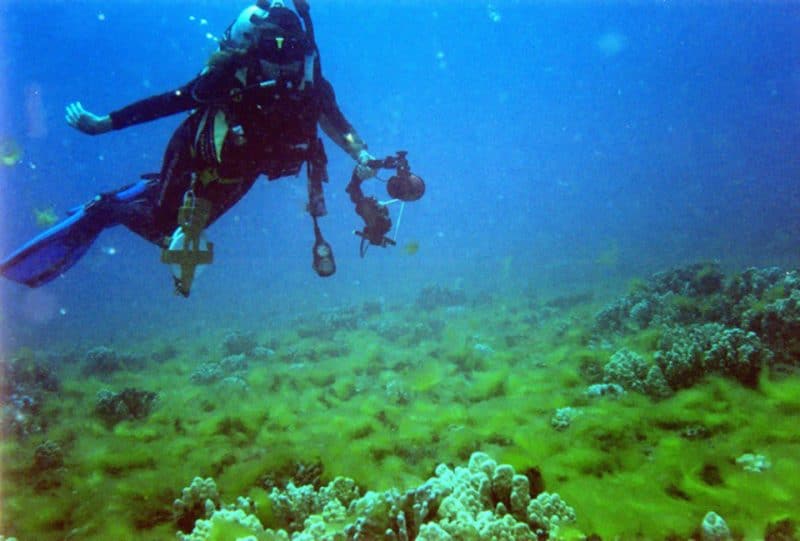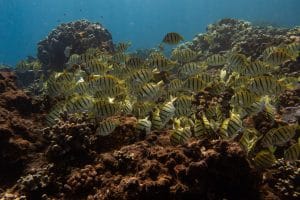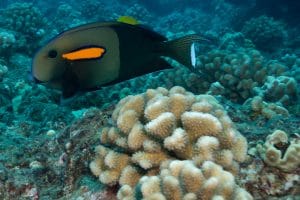
Photo by Chris Doerr.
Have you ever walked along Ka‘anapli Boardwalk and noticed signs explaining the Kahekili Herbivore Fisheries Management Area (KHFMA) project? Kahekili (or Airport) Beach is one of our favorite places to go shore diving so we love telling the story of how special this place is! If you’ve been shore diving there with us before, we’ve likely pointed out a sign or two. Taking some extra time to read these signs will really get your conservationist senses tingling! Being one of eight regulated fishing areas in Maui County, you know that means this place is pretty special. So, what’s the hype all about?
Let’s start with a little backstory…
Research from the early 2000s here in Ka‘anapali and Honokowai showed diminishing results for coral growth due to major algal blooms. These algal blooms were a shock at first, but soon were linked to freshwater springs that have been pushing out nutrient-rich water (read: pollution from the Lahaina Wastewater Treatment Facility), for the past 15 years. Too much algae proved to be a major problem, throwing off the balance of this coral reef ecosystem. In combination with this, researchers found surprisingly low numbers of algae-eating fish, especially parrot fish and surgeonfish.

Algal Bloom at Kahekili in 2001. Photo from NOAA Pacific Islands FIsheries Science Center.
With high populations of algae and low populations of algae-eating fish, there began to be a negative effect on the reef, such as:
- Unhealthy coral. In a major algal bloom, algae covers the coral, almost creating a blanket over it. When this happens, the coral’s photosynthetic algae is unable to receive the sunlight that it needs to keep the coral alive and well.
- Too much bacteria. Algae releases sugar into the water, which fuels bacteria growth. The increased amount of bacteria creates an imbalance by consuming too much oxygen, suffocating the coral.
- Low algae consumption. Before becoming a regulated fishing area, researchers noted low numbers of herbivorous, algae-eating fish. With an overwhelming amount of algae, there simply weren’t enough herbivorous fish to keep up with it.
So, there’s a problem…now what?

Grazing fish. Photo by Victoria Martocci.
Well, that’s where fisheries management areas, such as the Kahekili Fisheries Management (KHFMA), come into play! Taking, injuring, or catching certain marine species is prohibited in these kinds of management areas. Management areas are really important as they act like a marine life refuge, in an attempt to support the ecosystem’s balance. Added bonus: they provide great locations for eco-tourism activities like snorkeling and diving!
Established in 2009, the KHFMA was created to protect herbivorous fish species and increase algae consumption on the reef.
Hawai‘i’s Division of Aquatic Resources prohibits the following at Ka‘anapali:
- To injure, kill, possess, or remove any rudderfish (nenue), parrotfish (uhu), or surgeonfish.
- To injure, kill, possess, or remove any sea urchin.
- To feed or deliberately introduce any attractant, directly to or in the vicinity of any marine life, except while fishing for permitted marine life.
Grazers play an important role in a coral reef ecosystem, keeping algae growth in check. Protecting herbivorous fish allows for an increase in grazing populations, which means that there are more fish to eat the fast-growing algae. The KHFMA was established by conservationists, researchers, and the Maui Nui community in hopes of decreasing the number of large blooming events like we saw at Kahekili Beach in the early 2000s.
So has the KHFMA been successful in creating balance?

Orange-Band Surgeonfish, an herbivorous fish. Photo by Victoria Martocci.
After establishing the KHFMA , Kahekili Beach became a research hotspot! Studies showed that daily herbivore consumption of algae rose from 20.8% to 67.0%. Recent surveys have shown a huge increase in herbivorous fish and urchin populations, as well as fewer algal blooms!
Researchers working with the KHFMA also found that different grazers prefer different species of algae. So by protecting different species of grazers, the reef may be able to better manage algal growth or overgrowth. By establishing the KHFMA, researchers have been successful in finding a grazer/algae balance, providing balance to the entire reef ecosystem.
A Maui success story!
Next time you’re walking the Ka‘anapali Boardwalk or relaxing at Kahekili Beach, be sure to check out the signs and grab an informative pamphlet! It makes us proud knowing that our community came together to help protect such a beautiful coral reef ecosystem.
And next time you go shore diving with us at Kahekili Beach, remember to give a round of applause to the herbivorous fish for providing balance to our reefs!